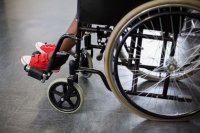Supporting Students in the Hospital
One teacher shares her advice for teaching a student who is hospitalized and her tips for reentry into the classroom.
Your content has been saved!
Go to My Saved Content.Almost every student will miss a few days of school at some point for minor illness or injury, but some students experience prolonged absences from school due to debilitating illnesses or injuries.
As a teacher juggling many responsibilities, you might feel overwhelmed trying to meet the needs of your hospitalized student, but teachers can be a steadfast face of normalcy for a child whose entire world has been turned upside down. Find ways to help hospitalized students and those transitioning back to the school environment.
Create a Plan
Establishing a point of contact for the student is an important first step. Some hospitals employ educational liaisons to coordinate a student’s plan, ensure that the release of records form is signed, provide the relevant medical paperwork to the right contact at the school, and monitor the student’s academic progress while in the hospital. If there is not a point person at the hospital, talk with your school’s social worker about how to coordinate care. Keep the 504 plan contact and IEP specialist informed from day one in case there is a need for accommodations or specialized instruction.
Establish a plan for communication with the student. Determine the best way to communicate: phone, email, or another online method. If multiple teachers need to assign work, designate one teacher as the main point of contact.
A hospitalization during the school year is exhausting and stressful for even the most organized and emotionally mature students. Streamlining assignments to focus on only the most relevant content will help a hospitalized student stay engaged and up to speed. Laying out several weeks of assignments can help a hospitalized student work ahead as he or she feels able.
Consider ways to accommodate or modify assignments for a hospitalized student. For example, the student could listen to an audiobook and verbally summarize the chapters instead of reading a printed book and writing responses to essays. This will help students who are experiencing cognitive fatigue, impaired fine motor skills, or decreased vision.
Some classmates may have learned details about the child’s hospitalization directly from the child or family, but it’s best not to share any specific medical information with the whole class unless you have explicit permission and a request from the parents to do so. When sharing information with the other students, speak in a calm, neutral tone, and be as clear and honest as you can. Avoid adding your own assumptions about the course of recovery or when the child may return to school.
Students may feel worried about their friend and confused about what happened. Journaling can be one way to help older students process their responses to their friend’s absence.
Stay Engaged
If you want to visit a hospitalized student, ask the family if the student wishes to receive visitors, and confirm that the student is medically cleared to receive visitors. It can be helpful to visit with the school social worker, especially if there are particular forms that require signature. Ask the family in advance if there are any precautions to take such as wearing a mask to prevent the spread of germs.
Check with the family or nurse about the child’s stamina for social interaction. If a visit is not feasible, arrange for cards and posters from classmates and school staff. Simple messages work well for cards and posters. Stickers are a fun and easy addition for younger elementary students to add to their cards.
Don’t limit communication with the student to only the specific assignments. Share classroom projects and schoolwide events to help the student feel connected to his or her community while away. For example, it may be possible for the child to go on an outing to the school. Find other ways to engage the student, such as:
- Including her vote in the student council election,
- Taking a picture of the new bulletin board when you start a unit and asking him to offer a suggestion for a contribution to the board, or
- Sending her family a short video of a school event.
Prepare for the Student’s Return
Schedule a multidisciplinary reentry meeting prior to the expected return date. Don’t forget to invite the school nurse. At the meeting, be sure to review paperwork from the medical team about medications, physical restrictions, and recommendations for classroom-based instruction.
If the student has limited mobility, invite him to practice navigating his schedule of classes at a time when other students are not in the building. Consider starting with half-days before transitioning to a full schedule.
Even if she did not experience any cognitive impairment and completed all the work during the hospitalization, the student will likely still have academic gaps from missed instruction. You may notice small changes in attention, judgment, memory, or behavior over time. Monitor academic and behavioral progress, track changes you observe, and communicate regularly with the family and other school team members.
It is normal for a hospitalized student to feel physically tired and emotionally anxious as he adjusts back to school. Remember that he is dealing with a significant and possibly life-changing medical event, trying to make up weeks of missed instruction, and keep up with the demands of his current classes. Offer empathy and continued academic support, and keep checking in with the student.
